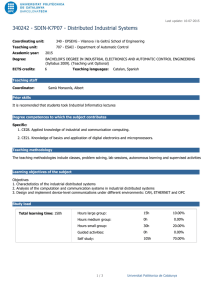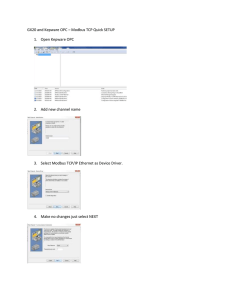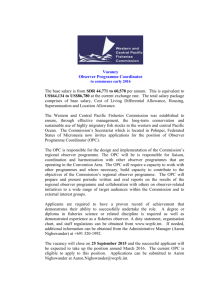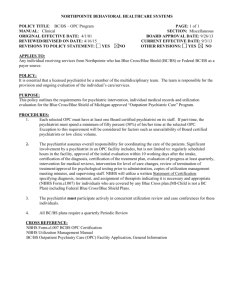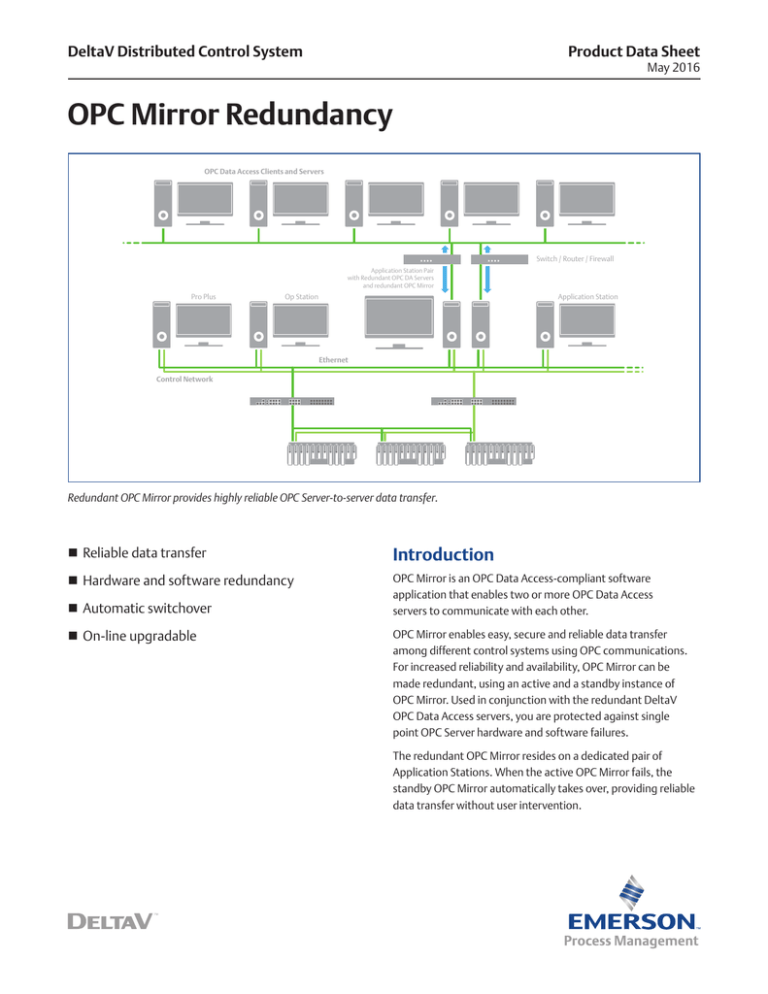
DeltaV Distributed Control System
Product Data Sheet
May 2016
OPC Mirror Redundancy
OPC Data Access Clients and Servers
Switch / Router / Firewall
Application Station Pair
with Redundant OPC DA Servers
and redundant OPC Mirror
Pro Plus
Op Station
Application Station
Ethernet
Control Network
Redundant OPC Mirror provides highly reliable OPC Server-to-server data transfer.
Reliable data transfer
Introduction
Hardware and software redundancy
OPC Mirror is an OPC Data Access-compliant software
application that enables two or more OPC Data Access
servers to communicate with each other.
Automatic switchover
On-line upgradable
OPC Mirror enables easy, secure and reliable data transfer
among different control systems using OPC communications.
For increased reliability and availability, OPC Mirror can be
made redundant, using an active and a standby instance of
OPC Mirror. Used in conjunction with the redundant DeltaV
OPC Data Access servers, you are protected against single
point OPC Server hardware and software failures.
The redundant OPC Mirror resides on a dedicated pair of
Application Stations. When the active OPC Mirror fails, the
standby OPC Mirror automatically takes over, providing reliable
data transfer without user intervention.
OPC Mirror Redundancy
Benefits
Reliable data transfer. OPC Mirror redundancy consists of an
active and standby OPC Mirror. If the active OPC Mirror or its
associated Application Station detects a failure, the standby
OPC Mirror assumes the active role, providing reliable data
transfer. Your OPC communications are protected against
unexpected failures.
Hardware and software redundancy. The redundant
OPC Mirror resides on a pair of Application Stations.
One Application Station is dedicated to the active OPC Mirror
and the other Application Station is dedicated to the standby
OPC Mirror, providing hardware and software redundancy.
Automatic switchover. If the active OPC Mirror or its
associated Application Station detects a failure, the standby
OPC Mirror assumes the active role automatically, with no
user intervention required. The standby OPC Mirror is in “hot
standby” mode, so switchover occurs quickly. Depending
on the failure condition and OPC redundancy configuration,
the failed OPC Mirror and Application Station will reboot and
automatically assume the standby role, restoring OPC Mirror
redundancy with no user intervention.
On-line upgradable. Since the redundant OPC Mirror resides
on a pair of Application Stations, OPC Mirror can be upgraded
online. Just like the DeltaV controllers, you can upgrade the
standby OPC Mirror and its associated Application Station while
the active maintains OPC communications, then manually
switch over to the upgraded Application Station.
Product Description
OPC Mirror provides real-time, read/write data transfer between
two or more OPC Servers. For critical OPC data communications
where you can’t afford interruptions, the OPC Mirror offers
OPC Server-to-Server communication redundancy. You can
add a standby OPC Mirror that operates in hot standby mode,
replicating the operation of the active OPC Mirror. Since OPC
Mirror works with the redundant DeltaV OPC Servers, you can
add an active and standby OPC Mirror to the Application Station
pair hosting the redundant DeltaV OPC Servers to provide
complete DeltaV OPC communication redundancy. The active
OPC Mirror connects to the active DeltaV OPC Server and the
standby OPC Mirror connects to the standby DeltaV OPC Server,
for a one-to-one, OPC-Mirror-to-DeltaV-OPC-Server relationship.
www.emersonprocess.com/deltav
May 2016
When a monitored fault is detected, the active OPC Mirror fails
over to the standby OPC Mirror, which then assumes the active
role. Your OPC communications continue on the “new” active
OPC Mirror without losing OPC communications. In addition,
the DeltaV Event Chronicle stores a record of each OPC Mirror
switchover and the reason it occurred, if known.
The redundant OPC Mirror resides on a pair of DeltaV
Application Stations. One copy of OPC Mirror must be installed
on each Application Station in the Application Station pair.
OPC Mirror redundancy is configured in DeltaV Explorer
from the Application Station Properties dialog. OPC Mirror
redundancy must be configured with DeltaV OPC Server
redundancy. Then, during DeltaV workstation configuration,
you identify the Application Station that will host the initial
active OPC Mirror and the Application Station that will host
the initial standby OPC Mirror.
Although there are two physical Application Stations that host
the redundant OPC Mirror, they are seen by the DeltaV system
as a single workstation. The Application Station pair is known by
the name configured for the initial active OPC Mirror node (e.g.
REDOPC). The initial standby OPC Mirror node has the same
name appended with _S (e.g. REDOPC_S). The Application
Station pair appears in the DeltaV Explorer system tree as a
single icon.
By configuring OPC Mirror redundancy, a redundancy
subsystem is created on the Application Station pair.
The redundancy subsystem transfers messages and data
between the Application Stations, keeping the active and
standby OPC Mirror synchronized. You only need to configure
the OPC item mappings on the active OPC Mirror—the
redundancy subsystem ensures that the configuration
is copied to the standby OPC Mirror.
OPC Mirror redundancy also includes redundant Assigned
Modules on the Application Station pair. Any control modules
assigned to the Application Station pair are redundant. Landing
your OPC data in control modules running in the Application
Station pair ensures redundant module execution, just like in
redundant DeltaV controllers. When you assign control modules
to execute in the Application Station pair, the redundancy
subsystem ensures that the modules running in the standby
Assigned Modules subsystem are synchronized with the
modules running in the active Assigned Modules subsystem.
2
OPC Mirror Redundancy
The DeltaV Diagnostics Explorer includes an OPC Mirror and
OPC Mirror redundancy subsystem. The OPC Mirror and OPC
Mirror redundancy subsystems provide diagnostics information
for OPC Mirror, the OPC Mirror server connections (“pipes”),
and the connected OPC Servers, as shown below.
May 2016
The active OPC Mirror and its connected active DeltaV OPC
Server work together to provide one-for-one redundancy with
the standby OPC Mirror and its connected standby OPC Server.
If a problem is detected with any of the monitored components
on the active OPC Mirror node, the entire Application Station
will switch over to the standby OPC Mirror node, with the
standby OPC Mirror and the standby DeltaV OPC Server
assuming the active role.
DeltaV Diagnostics Explorer allows you to view OPC Mirror redundancy diagnostics data.
When you configure OPC Mirror redundancy, the Application
Station itself is not redundant, only OPC Mirror, the DeltaV
OPC Server and Assigned Modules subsystem. In addition,
the Application Station pair is dedicated to redundant
OPC communications. Once the Application Station pair is
configured for OPC redundancy, no other subsystems on the
Application Station pair may be enabled.
When you configure the Application Station pair for the first
time, you identify the initial active and the initial standby OPC
Mirror nodes. However, during operation, either Application
Station can host the active OPC Mirror, depending on the last
switchover. Since either OPC Mirror can be the active OPC
Mirror, each Application Station should be sized to handle
the active OPC Mirror role.
www.emersonprocess.com/deltav
The automatic OPC Mirror switchover protects you in the event
of a failure. If the active OPC Mirror fails, the standby OPC
Mirror automatically becomes the active OPC Mirror. During
normal operation, the standby OPC Mirror is in “hot standby”
mode, so switchover from the failed active to the standby OPC
Mirror occurs immediately after the redundancy subsystem
has detected the failure and triggered the switchover. The
hot standby mode adds more load to the DeltaV system, but
ensures immediate availability of OPC data after switchover.
During Application Station switchover, which typically takes
a few seconds (depending on the Application Station hardware
and the size of the OPC configuration), the OPC data will
hold the last value, ensuring bumpless data transfer. A
switchover event is generated and collected in the DeltaV
Event Chronicle, providing notification to the operator that
a switchover has occurred.
3
OPC Mirror Redundancy
A failed active OPC Mirror and associated Application Station
will remained failed by default, waiting for the cause of the
failure to be investigated. While the failed OPC Mirror is in the
failed state, switchovers are disabled and the active OPC Mirror
is in simplex mode. However, you can configure the Application
Station pair to automatically reboot the failed Application
Station to allow the failed OPC Mirror to assume the standby
role without user interaction. A standby OPC Mirror that
assumes the active role will remain the active OPC Mirror until
the next switchover.
Some of the events that can cause a switchover are:
OPC Mirror failure
Connected OPC Server failure
DeltaV software processes failure
Application Station hardware failure
Communications failure between the active and standby
OPC Mirror
Communications failure between connected OPC Servers
Manual switchover from Diagnostics
From the DeltaV Diagnostics Explorer, you can see the status of
the active and standby OPC Mirror. Indication of the active and
standby OPC Mirror status is also available from a redundancy
faceplate graphic display located in the system tray on the
Application Station pair.
May 2016
Mirror to the standby OPC Mirror. During switchover, the failed
OPC Mirror will hold last value until the standby OPC Mirror
assumes the active role. The system is upgraded without losing
OPC communications. You can then upgrade the standby OPC
Mirror node at your convenience.
The active OPC Mirror and the active DeltaV OPC Server reside
on the same Application Station. The standby OPC Mirror and
the standby DeltaV OPC Server reside on a second Application
Station. A 3rd-party OPC server may be installed on the same
Application Station as the active OPC Mirror and active DeltaV
OPC Server. In this architecture, the 3rd-party OPC server
should also be installed on the Application Station that hosts
the standby OPC Mirror and the standby OPC Server. Doing this
will prevent data loss when the failed active OPC Mirror switches
over to the standby OPC Mirror, when the failed active OPC
Mirror, including the 3rd-party OPC server, is shut down.
The marshalling of the connection between the 3rd-party OPC
server and the active OPC Mirror is handled automatically by
the OPC Mirror software. The active and standby OPC Mirror
are monitoring the OPC communications, but only the active
OPC Mirror is transferring data. With a second 3rd-party OPC
Server on the second Application Station, failure of the active
OPC Mirror and switchover to the standby OPC Mirror does not
impact communications to the 3rd-party OPC server, providing
bumpless transfer of OPC data. During switchover, OPC Mirror
holds the last good value. Once the standby OPC Mirror
becomes active, real-time OPC communications will resume.
3rd Party
OPC Server
3rd Party
OPC Server
OPC Mirror
OPC Mirror
DeltaV OPC
Server
DeltaV OPC
Server
Assigned
Modules
Assigned
Modules
Application Station Pair (Active/Standby)
You can upgrade the Application Station pair online without
losing OPC data communications between the OPC Servers
connected through the redundant OPC Mirror. Simply upgrade
the standby OPC Mirror node, and then perform a manual
switchover. OPC data transfer will switch from the active OPC
www.emersonprocess.com/deltav
A 3rd-party OPC server may also be installed on a 3rd-party
workstation. In this architecture, the active OPC Mirror and
standby OPC Mirror will be configured to connect to the remote
3rd-party OPC Server.
4
OPC Mirror Redundancy
May 2016
The marshalling of the connection between the 3rd-party OPC
server and the active OPC Mirror is handled automatically by
the OPC Mirror software. The active and standby OPC Mirror
are monitoring the OPC communications, but only the active
OPC Mirror is transferring data. Failure of the active OPC Mirror
and switchover to the standby OPC Mirror does not impact
communications to the 3rd-party OPC server, providing
bumpless transfer of OPC data. During switchover, OPC Mirror
will hold the last good value. Once the standby OPC Mirror
becomes active, real-time OPC communications will resume.
In this architecture, the 3rd-party workstation and 3rd-party
OPC server are a single point of failure; therefore, failure of
the 3rd-party OPC workstation or server will cause a loss in
data communications.
From the OPC Mirror Configuration client, you can enable
server monitoring. Once enabled, you configure the desired
switchover behavior. The options are to switch over if any OPC
server connected to the active OPC Mirror fails or to switch over
if all OPC servers connected to the active OPC Mirror fail. The
redundant OPC Mirror Server Monitor feature enables status
of 3rd-party OPC servers to influence the operation of the
OPC Mirror redundancy, increasing your OPC communication
reliability and availability.
3rd Party Workstation
3rd Party
OPC Server
OPC Mirror
OPC Mirror
DeltaV OPC
Server
DeltaV OPC
Server
Assigned
Modules
Assigned
Modules
Application Station Pair (Active/Standby)
The redundant OPC Mirror is well integrated with the redundant
DeltaV OPC Servers and the DeltaV redundancy subsystem.
The redundant OPC Mirror is aware of the status of the DeltaV
OPC Servers and will switch over if a problem is detected in the
DeltaV OPC Server, communications to the DeltaV OPC Server,
or in the Application Station itself. The redundant OPC Mirror
may also be configured to monitor the status of its connected
3rd-party OPC servers and take action based on the status of
the 3rd-party OPC servers.
The redundant OPC Mirror Server Monitor feature allows you
to configure the redundant OPC Mirror to monitor the status
of the connected 3rd-party OPC servers and switch over if
communications are lost between the active OPC Mirror and
the 3rd-party OPC server.
www.emersonprocess.com/deltav
In the example architecture noted above, where a simplex 3rdparty OPC server is located on a 3rd-party workstation, failure
of the network connection between the active OPC Mirror and
the 3rd-party OPC server would typically result in a loss of OPC
data communications.
With the OPC Mirror Server Monitor, the loss of data
communications due to the failed network connection would
be detected by the Server Monitor and the active OPC Mirror
would switch over to the standby OPC Mirror.
Redundant OPC Mirror is supported only on the DeltaV
Application Station. Simplex OPC Mirror may be used with
redundant DeltaV OPC Servers. The simplex OPC Mirror may
be installed on another DeltaV workstation or a 3rd- party
workstation. The simplex OPC Mirror does not provide the
Server Monitor feature included in the redundant OPC Mirror.
A redundant OPC Mirror may be licensed for up to 50 OPC
server connections. Each DeltaV system will support up to 20
redundant OPC Mirror instances (residing on 20 Application
Station pairs). For more information on the Application Station,
refer to the Application Station product data sheet.
5
OPC Mirror Redundancy
May 2016
Ordering Information
Description
Model Number
Redundancy License for OPC Mirror
VE2212RED
Related Products
Redundancy License for OPC Data Access Servers, VE2224RED
OPC Mirror. Transfers thousands of values
back and forth between your DeltaV system
and other OPC- compliant systems.
One copy of OPC Mirror installed on each Application Station
in the Application Station pair.
Two Dell computers (workstation or server class, as required).
Application Station Software Suite. Integrate your
DeltaV system with 3rd party systems and applications
on a DeltaV workstation. Includes a scalable DeltaV
Continuous Historian and DeltaV OPC Data Access server.
It is recommended that the Dell computers used for the
Application Station pair be the same model.
The Application Station pair used for OPC Mirror redundancy
must be dedicated to OPC communications; you cannot
enable any other subsystem on the Application Station pair
and you should not install or run non-OPC based applications
on the Application Station pair.
If you’re using OPC Mirror with non-DeltaV OPC servers, then
you should follow the instructions provided by the 3rd-OPC
server supplier when configuring the 3rd-party OPC server.
DeltaV v10.3 or later.
Backup and Recovery. Provides data backup
and disaster recovery for DeltaV system and
associated process control data.
Prerequisites
One Application Station Software Suite license with the
appropriate DeltaV OPC Server scale up, VE2201Sxxxxx
(where xxxxx is the number of OPC data values required, from
00250 to 30000).
One OPC Mirror license, VE2212Sxxx
(where xxx is the number of OPC server connections required,
from 002 to 050).
©2016, Emerson Process Management. All rights reserved.
Emerson Process Management
Asia Pacific: 65.6777.8211
Europe, Middle East: 41.41.768.6111
North America, Latin America:
T 1 (800) 833-8314 or
1 (512) 832-3774
www.emersonprocess.com/deltav
The Emerson logo is a trademark and service mark of Emerson Electric Company. The DeltaV logo
is a mark of one of the Emerson Process Management family of companies. All other marks are
the property of their respective owners.
The contents of this publication are presented for informational purposes only, and while every
effort has been made to ensure their accuracy, they are not to be construed as warrantees or
guarantees, express or implied, regarding the products or services described herein or their
use or applicability. All sales are governed by our terms and conditions, which are available on
request. We reserve the right to modify or improve the design or specification of such products
at any time without notice.


